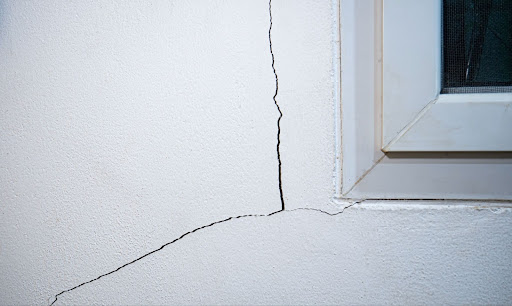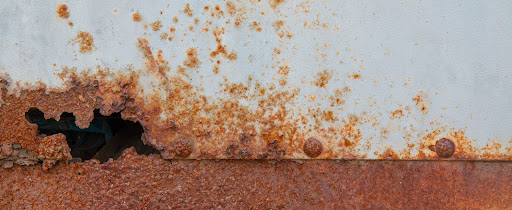8 Signs of Structural Damage You Should Keep an Eye Out For
Structural damage in a home is a serious concern that affects the value and safety of the property and the well-being of its occupants. Structural damage refers to any significant harm or deterioration that affects the integrity of a building’s structure. This type of damage goes beyond mere cosmetic issues and impacts a building’s stability and safety.
Identifying these problems early gives you the chance to get structural repairs before these problems become too serious. In this article, we’ll go over eight signs of structural damage, as well as the causes of structural damage and what to do if you find it.
1. Cracks in Walls or Foundations
One of the most visible signs of potential structural damage is cracks in your walls or foundation. Small, hairline cracks might be more a cosmetic issue than anything else.
But larger cracks, especially those that are wider at the top than the bottom, indicate structural problems, usually with the foundation. These cracks compromise the structural integrity of the building and should be evaluated by a professional.
This type of crack suggests that part of the structure is moving or settling more than another part, leading to uneven pressure and stress on the building’s materials.
You should specifically keep an eye out for stair-step cracks in brick or masonry. Stair-step cracks are usually a result of differential settling of the foundation, where one part of the foundation sinks or settles more than another. This happens from soil erosion, expansive soils, or inadequate soil compaction when the house was originally constructed.
2. Uneven, Sagging, or Bulging Floors
Uneven, sagging, or bulging floors could be a sign of structural damage. Uneven floors are often a symptom of a problem with your home’s foundation or support beams. Take note if the floor is slanting towards one side of the building or if the floor feels springy or bouncy.
One way you may notice these issues is by feeling them in the floor as you move around your house. Another way is to gauge how the floor lines up with the bottoms of doors or appliances.
3. Doors and Windows That Stick or Won’t Close Properly
Doors and windows sometimes stick or don’t shut properly. This might be for benign reasons. Changes in humidity, for instance, cause wood to expand and contract, affecting how doors and windows fit in their frames. Aging or damaged hardware or paint buildup also lead to sticking or crookedness.
However, doors and windows that used to open and close smoothly but now stick or won’t close properly are another indicator of structural problems. This happens when the frame of the house shifts, causing misalignment. It’s a subtle sign that your home needs structural repairs.
4. Gaps Around Doors and Windows
Gaps appearing around doors and windows where they meet the frame is another sign of structural movement. Unlike crooked door hinges or sticking windows, there is no chance these gaps are caused by old hardware or changes in humidity.
These gaps might indicate that the structure of your home has shifted, which leads to more significant structural damage if not addressed. Your first sign there’s a gap may be a draft near a closed door or window.

5. Bowed Walls
Bowed walls are a clear sign of structural distress. This type of warping or deformation is often a sign that the load-bearing elements of your home, such as the walls, joists, or support beams, are under excessive stress or are failing. This is a serious concern that requires immediate attention.
Bowed walls are sometimes subtle and not immediately apparent. Check for bowed walls by taking a long straightedge or a laser level and placing it against the wall at various points, both vertically and horizontally. If there is a noticeable gap between the straightedge and the wall, or if the laser level deviates from a straight line, the wall may be bowing.
6. Cracked or Leaning Chimney
A cracked or leaning chimney is a sign of structural damage. The chimney is typically built on a foundation separate from the rest of the house. If this foundation settles or shifts differently than the main house foundation, it leads to a leaning or cracked chimney.
A leaning chimney that tilts away from the house is an obvious sign that something isn’t quite right. However, there are other ways chimneys tell us there’s something wrong.
Cracks in the chimney, especially those that run vertically, are another sign of structural stress. In some cases, you might notice gaps where the chimney separates from the side of the house, or there may be evidence of crumbling or deteriorating bricks or mortar.
8. Visible Corrosion of Structural Steel
If your home has any exposed steel components, visible corrosion might be a sign of structural problems. Rust and corrosion weaken steel, compromising its ability to support your home effectively.
Corrosion is the natural process by which metal deteriorates due to a chemical reaction, often involving moisture and oxygen. In the case of structural steel, this corrosion leads to a reduction in the thickness of the steel, weakening its load-bearing capacity.
The most obvious sign of corrosion in steel is the presence of rust, which typically appears as a reddish-brown flaking or staining on the surface of the metal. In more advanced stages, you might notice pitting or scaling, where parts of the metal surface have corroded away, leaving a rough or uneven texture. In severe cases, the steel may exhibit deformities or significant thinning, indicating substantial material loss.

Causes of Structural Damage
Structural damage is caused by a variety of factors. Here are some of the most common causes of structural damage:
- Foundation Issues: Problems in the foundation, such as settling, shifting, or cracking, leading to structural damage. Shifting causes undue stress to certain parts of the building. Foundation issues might be due to soil movement, poor soil conditions, or inadequate foundation design.
- Water Damage: Prolonged exposure to moisture weakens structural materials like wood and steel, leading to rot, rust, and deterioration. Water damage is often a result of leaks, flooding, or poor drainage around the building.
- Aging and Wear: Over time, building materials degrade. Wood rots, metal corrodes, and concrete cracks and crumbles. Regular maintenance and timely replacement of materials are both crucial to prevent aging materials from causing structural damage.
- Environmental Factors: Natural events such as earthquakes, hurricanes, floods, droughts, and severe storms can cause immediate and severe structural damage. Environmental factors also include things like soil erosion or tree roots growing into foundations.
- Poor Construction: Structural damage also stems from poor construction practices. Some of these practices include the use of substandard materials, inadequate design, or errors during the building process.
- Overloading: Structural damage can come from exceeding the weight capacity that a building or a component of a building was designed to handle. This occurs in industrial settings or when modifications are made to a building without proper reinforcement.
- Preventing Structural Damage: The best way to prevent structural damage is to get regular inspections of your home. Professional inspectors know what subtle signs of structural damage to look for and find damage or areas of concern before the problem becomes obvious to the layperson.
It also helps to understand the environmental factors that may affect your home. Educate yourself on weather patterns, soil types, and mold or pests to look out for. Educate yourself on your home and how it’s built, including how old it is and what type of foundation it has. If you’re considering building an add-on to your home, make sure the structure is able to handle it.
I’ve Found Signs of Structural Damage. Now What?
Addressing the cause of structural damage in your property isn’t something you can do on your own. Seek the expertise of a structural engineer or a specialized contractor. They can assess the extent of the damage, identify the underlying cause, and recommend appropriate structural repairs.
Solutions might include reinforcing or replacing damaged beams and joists, underpinning the foundation, or installing support structures like steel braces to stabilize the affected walls.
Remember, identifying and addressing structural damage early saves you time, money, and stress in the long run. Don’t wait until small issues become big problems.
Call Hudson Douglas Public Adjusters
Home or property insurance can offer some coverage for structural damage. But the world of property insurance and insurance claims can be daunting. We’re here to help with that.
At Hudson Douglas Public Adjusters, we understand the complexities and challenges of working with property insurance. Our team of experts is equipped to guide you through the process of working with your insurance to assess and repair any structural problems your home may face. We’re fluent in insurance and here to help you. Contact Hudson Douglas Public Adjusters today.



